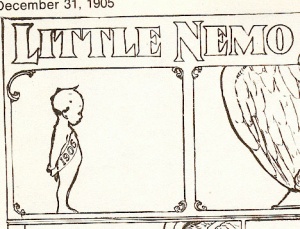New Years Babies
Listen to the Recess! Clip
| Author | John Cech |
| Air Date | 12/31/2002 |

New Years Babies Transcript
One of the fascinating figures who arrives at the turn of every new year is a little child who appears to take over the reins of life from an elderly figure, old father time, who represents the previous year — in other words, the past. This new year’s baby angel complete with a sash, sometimes with an over-sized top hat and party horn, has been appearing in newspaper cartoons and on greeting cards since the late 1800s, and he was already quite a familiar sight when America’s great comic strip artist, Winsor McCay, featured him, in a New Year’s Eve story for 1906.
But, of course, the figure of this magical, regenerative child is far older than that. The nineteenth century fantasy writer, George MacDonald touched on the child’s enigmatic origins when he asked, in his famous couplet: “Where did you come from Baby my dear?” and then had the child answer, “Out of the everywhere into the here.” In his remarkable novella, The Golden Key, MacDonald places this everywhere child at the center of the world and all its ways, and calls him the oldest being of all.
That eternal, shimmering baby appears in the pictures of the German Romantic painter, Philip Otto Runge. The child lies on his back, arms spread wide, ready to embrace everything that the universe has to offer. In William Blake’s Songs of Innocence and Experience, the child appears on a cloud to the poet, offering him inspiration. In Mozart’s The Magic Flute,three of these wondrous children offer celestial notes of hopeful encouragement to the beleaguered hero and heroine of the opera.
Renaissance paintings and sculpture are filled with the winged, naked little children called putti who inhabit the heavens, and who always seem to be hovering in the upper reaches of the canvas while the principals of the paintings are falling in love. They’re the children of Cupid, of course, who is, in his earliest form in ancient Greece, the oldest of the child gods — Hermes, who on the first day of his birth invents the alphabet, music, and sleight-of-foot magic. Hermes would grow up to become the messenger between the gods and mankind — you know him as the fellow with the wings on his heels.
So is it one of Hermes’ relatives who comes to visit us every New Year’s Eve — that fresh new child who is forever young, who is full of tricks, and full of invention; a messenger from the future here to occupy our present with us? I’d like to think so. It’s good to be reminded, as the clock ticks down and the ball drops, of that child’s eternal presence.